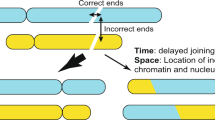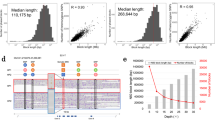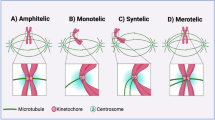Abstract
It has been known since the days of Boveri1 that neoplasia is associated with chromosomal aberration. The introduction, some 10 years ago, of chromosome banding techniques provided the impetus for the description of an immense number of such aberrations, and for the localization to individual chromosome bands of the breaks underlying the aberrations. Hypothetically, the breaks should comprise two essentially different kinds: primary breaks that are actively involved in the malignant development, and secondary breaks, coincidental to this process. In the search for a possible method to identify primary breaks in human cancer, I selected from the catalogue of chromosome aberrations now available2 those cases that had one single structural aberration as their sole deviation from normality. I report here that the breakpoints thus specified affect a surprisingly limited number of chromosomal regions, and conclude that these regions contain genes of prime importance to cancer development.
This is a preview of subscription content, access via your institution
Access options
Subscribe to this journal
Receive 51 print issues and online access
$199.00 per year
only $3.90 per issue
Buy this article
- Purchase on SpringerLink
- Instant access to full article PDF
Prices may be subject to local taxes which are calculated during checkout
Similar content being viewed by others
References
Boveri, T. Zur Frage der Entstehung maligner Tumoren (Fischer, Jena, 1914).
Mitelman, F. Cytogenet. Cell Genet. 36, 1–515 (1983).
Sandberg, A. A. The Chromosomes in Human Cancer and Leukemia (Elsevier, New York, 1980).
Spira, J. in Chromosomes and Cancer (eds Rowley, J. D. & Ultmann, J.) 85–97 (Academic, New York, 1983).
de la Chapelle, A. & Berger, R. Cytogenet. Cell Genet. 37, 274–311 (1983).
Mitelman, F. in Chromosomes and Cancer (eds Rowley, J. D. & Ultmann, J.) 61–84 (Academic, New York, 1983).
Levan, G., Ahlström, U. & Mitelman, F. Hereditas 77, 263–280 (1974).
Rowley, J. D. Proc. natn. Acad. sci. U.S.A. 74, 5729–5733 (1977).
Mitelman, F. & Levan, G. Hereditas 89, 207–232 (1978).
Mitelman, F. & Levan, G. Hereditas 95, 79–139 (1981).
Cairns, J. Nature 289, 353–357 (1981).
Klein, G. Nature 294, 313–318 (1981).
Pall, M. L. Proc. natn. Acad. Sci. U.S.A. 78, 2465–2468 (1981).
Rowley, J. D. Nature 301, 290–291 (1983).
ISCN Cytogenet. Cell Genet. 21, 309–404 (1978).
Bartram, C. R. et al. Nature 306, 277–280 (1983).
Author information
Authors and Affiliations
Rights and permissions
About this article
Cite this article
Mitelman, F. Restricted number of chromosomal regions implicated in aetiology of human cancer and leukaemia. Nature 310, 325–327 (1984). https://doi.org/10.1038/310325a0
Received:
Accepted:
Issue date:
DOI: https://doi.org/10.1038/310325a0
This article is cited by
-
Cytogenetic study on a new epithelial cell line, HNE-1, derived from nasopharyngeal carcinoma
Chinese Journal of Cancer Research (1991)
-
Genetic mapping in chromosome 21 and its implications for Down's syndrome and other diseases
Somatic Cell and Molecular Genetics (1987)
-
Non-random distribution of Alu-family repeats in human chromosomes
Molecular Biology Reports (1987)
-
Chromosomal insertion of human papillomavirus 18 sequences in HeLa cells detected by nonisotopic in situ hybridization and reflection contrast microscopy
Human Genetics (1987)
-
Aberrant breakpoints in chronic myelogenous leukaemia; oncogenes and fragile sites
Human Genetics (1986)



